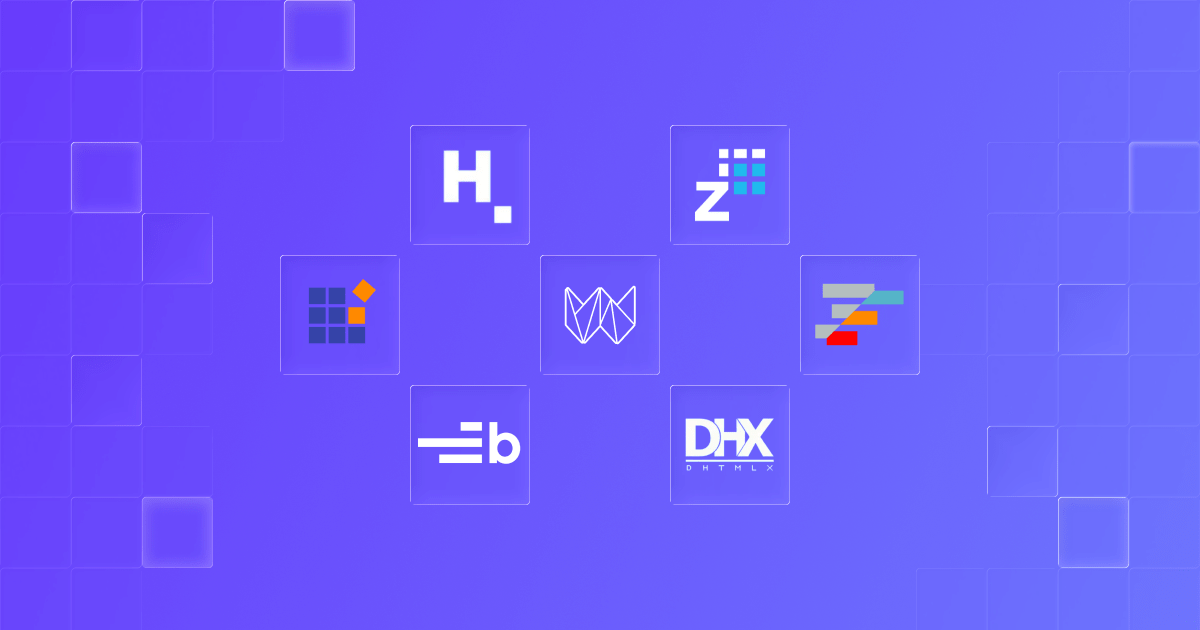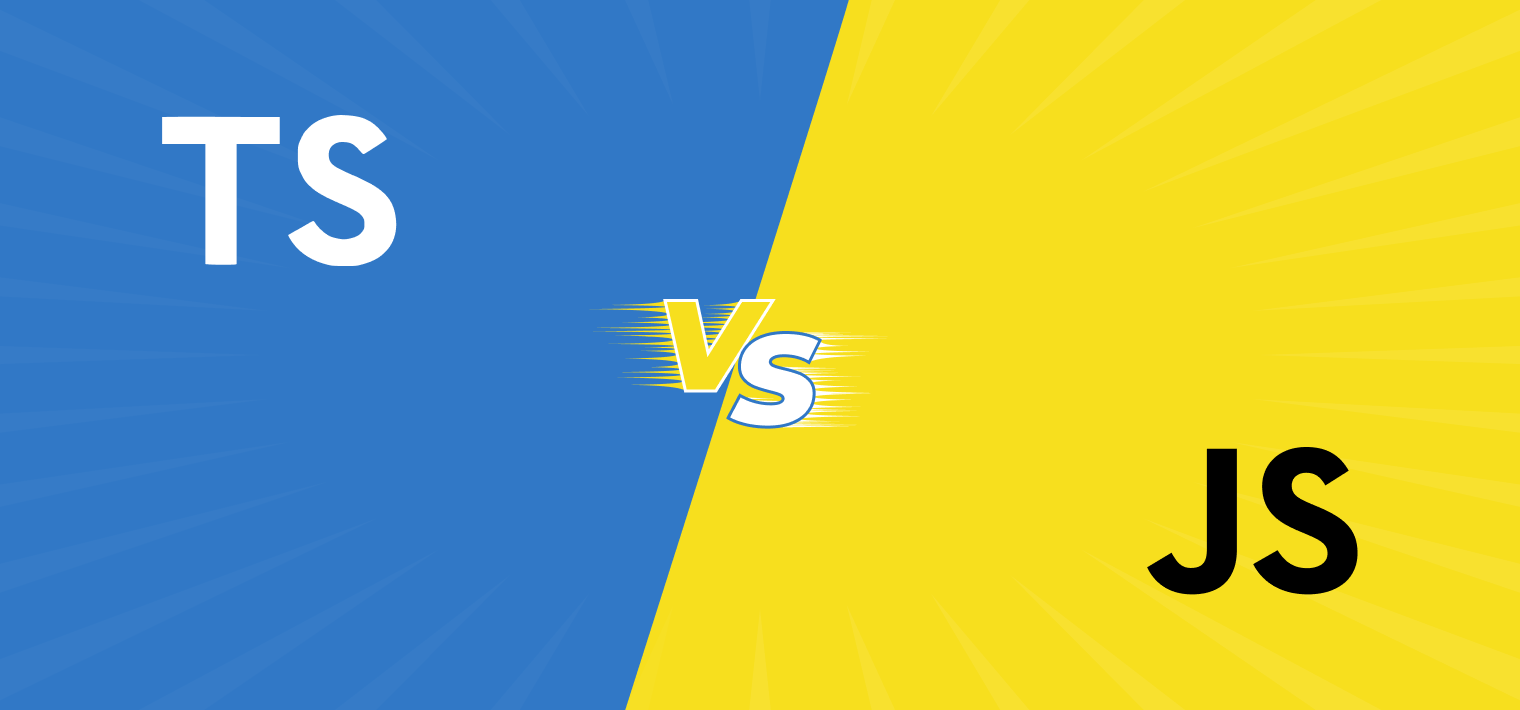When we start building an app or a website, we are usually challenged to choose the right tool for our context. This task becomes even more complex in view of a wide variety of JavaScript libraries and frameworks web developers have at their disposal in addition to the possibilities coming with programming in Vanilla JavaScript.
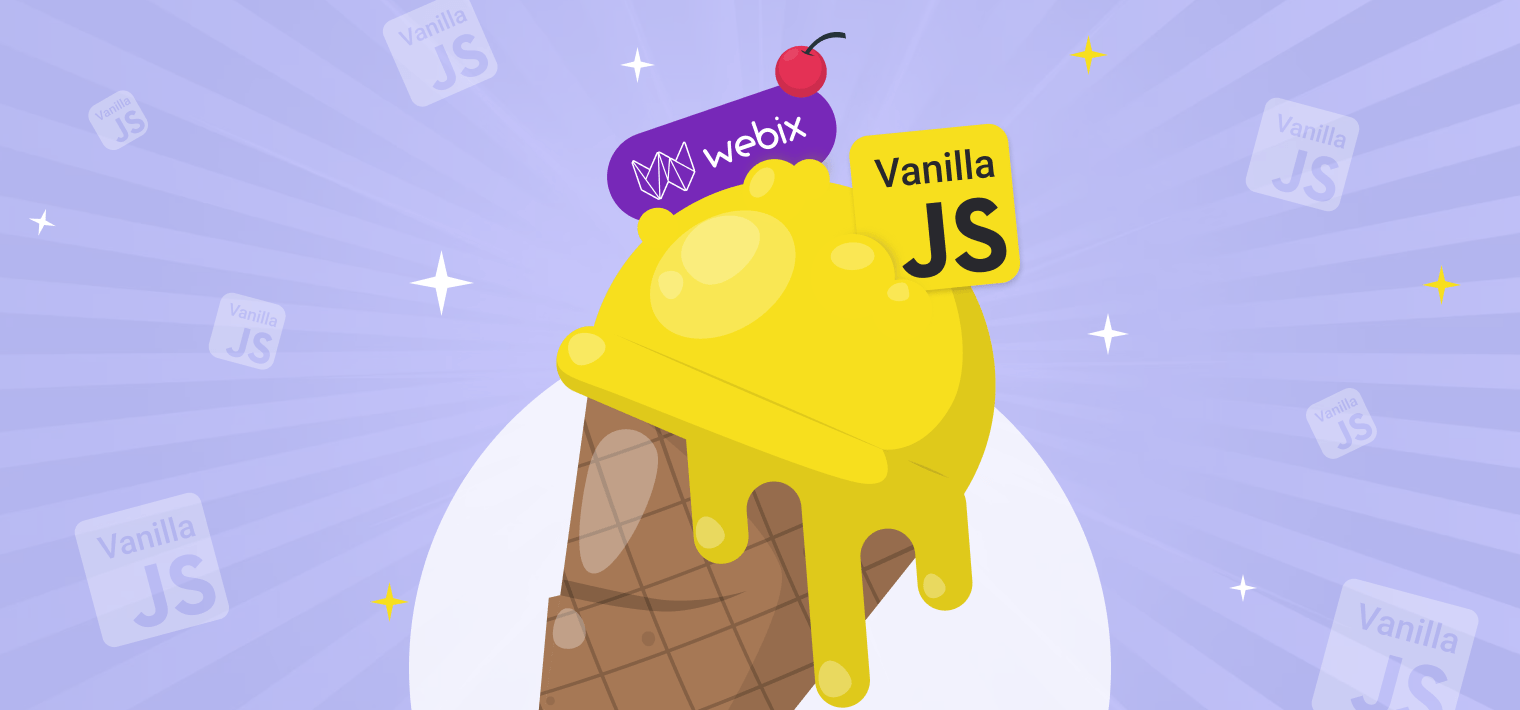
Updated September 2025
As developers, we often honor the facility and lightweight nature of Vanilla JS. It guarantees a clean and simple approach to developing web apps with no overhead of frameworks. However, when the developed application complexity is constantly growing, using Vanilla JavaScript can remind you of Sisyphean labor. Let’s explore what Vanilla JS is and discuss when it might be beneficial to consider using UI libraries like Webix.
What is Vanilla JavaScript?
As the Devil has lots of names — Lucifer, Satan and Beelzebub — JavaScript goes by different names that are simply synonyms: vanilla, plain, pure, or good old-fashioned JavaScript.
Vanilla JS means using the language in its basic form to build websites or web applications without relying on external ready-made components, UI libraries or any extra tools.
So if you are wondering “Is Vanilla JS a Framework?”, the answer is “No”.
It’s the digital equivalent of making pasta from scratch. Instead of grabbing a packet of spaghetti from the nearest supermarket. You take flour, eggs, a little salt, and knead the dough. Then, you roll it out and cut it by hand. You create everything from start to finish. Whether it will turn out to be a delicious dish or “spaghetti code” is another story.
Does anyone still use Vanilla JS?
Sound like something outdated and godforsaken? Hang on, below is a list of those who back up the claim that Vanilla JavaScript is still absolutely everywhere. Some of the biggest names in tech (and beyond) continue to rely on Vanilla JS in their codebases, for example:
- YouTube
- Yahoo
- Wikipedia
- X
- Amazon
- Netflix
- Stack Overflow

Image source: tenor
And this isn’t the full list. As you can see some of the most popular sites in 2025 are still spinning up classic JavaScript behind the scenes.
What is the difference between JavaScript and Vanilla JavaScript?
There is no difference between these two terms. The term “Vanilla JavaScript” is just a fancy way of saying “plain old JavaScript”. When they say something was built with Vanilla JS, they mean it was developed from scratch, using nothing but the raw JavaScript. No jQuery, no React, no shortcuts. Just you, the language, and the DOM.
By the way, the term only became popular thanks to a parody website that led novice users to believe that “vanilla” was a separate type of JavaScript. It jokingly presented it as a powerful framework — when, in reality, it was just an empty JS file.

Image source: vanilla-js.com website screenshot
Don’t tell me you fell for the same trick. 😀
TL;DR: To sum up Vanilla JS meaning, it is the core language that runs in web browsers and can be used to create interactive web applications. It means creating websites using only the tools available in every browser. It stores data in a unique way known as a column-oriented database, which enables apps to run faster and consume less memory. This means that your apps will work seamlessly across any browser, making them convenient for anyone to use. And since it doesn’t depend on external tools or libraries, your apps will load quickly and remain lightweight.

Seems like I’ve got carried away, and they say a picture is worth a thousand words. Here is an example of Vanilla JS code that changes text on HTML page:
<script>
const element = document.getElementById("myElement");
element.textContent = "New text";
</script>
Skip the Framework? Here’s When Vanilla JS Shines
Let’s first turn to some common cases when utilizing Vanilla JS is enough:
- creating single-page websites;
- developing websites with static content and a limited number of complex features;
- building lightweight small-scale applications with no or very limited number of repeated parts, i.e. there is no need for reusable components or UI state tracking;
- working with Content Management Systems that do not support frameworks.
Well, we have a short list of cases above. If you don’t see your project on this list, you might think learning pure JS is as skippable as an annoying ad on your favorite website. If you’re nodding along, the next paragraph is for you.
Why You Should Become a Vanilla JS Ninja Before Using Frameworks
I bet your bottom dollar frameworks are great. They save time, handle the messy stuff, and make us feel like coding superheroes. But it’s important to remember that without a solid understanding of Vanilla JavaScript, you’re basically flying a plane on autopilot without knowing how to land it. The idea of eliminating pure JS is actually inviable despite being so tempting.
So, before you jump into React, Vue, or whatever’s trending today, let’s talk about why learning plain JavaScript first is essential.
1. You’re Going to Write Vanilla JavaScript Anyway
No matter how much you love your UI framework, one day you’ll inevitably find yourself writing plain JS. Here are some reasons why:
- Frameworks don’t do everything. Even the super-duper feature-packed ones sometimes lack some small custom chip, so you have to create your own plugins or design decisions.
- You’ll have to extend functionality. Sometimes, you face a task of extending the existing features of the framework to meet our needs.
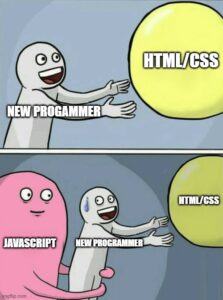
Image source: imgflip.com
2. Understanding JavaScript Makes You a More Valuable Developer
Think of Vanilla JS as the foundation of your coding house. If that foundation is weak, it doesn’t matter how fancy your React or Angular skills are — eventually, one day all may fall apart. Learning Vanilla JS helps you:
- Master the weird but powerful things like closures, event delegation, and the “this” keyword (because trust me, “this” will confuse you at some point).
- Optimize performance by knowing when not to rely on heavy framework abstractions.
- Debug problems faster because you actually understand what’s happening under the hood.
3. Frameworks Come and Go, But JavaScript Stays Forever
Do you remember jQuery? It was the king of JavaScript once. It’s basically a relic now. The most widely used frameworks of tomorrow might experience the same fate. However, Vanilla JS itself? That will remain in place. No matter what new technology emerges, if you master it, you’ll always be ahead of the curve.
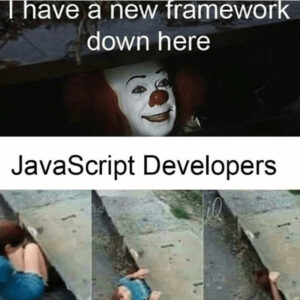
Image source: r/ProgrammerHumor
4. Debugging Without Knowledge is a Nightmare
Ever seen an error in a framework and had no idea what went wrong? Without knowing JS, debugging turns into guesswork. But when you understand the language:
- You can actually fix things rather than blindly Googling bug reports.
- You won’t be dependent on updates to fix your problems.
- You’ll write cleaner, more efficient code (which means fewer headaches later on).
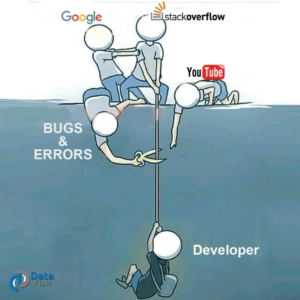
Image source: r/ProgrammerHumor
Essential JavaScript Concepts to Save Like Your Cache Saves Cat Memes
Since we’ve already touched on this topic, let’s open the curtain and take a closer look at the concepts that you, as a JS newbie, will have to learn. We’ve gone through everything described in MDN web docs in detail to give you the rundown. Before diving into a framework, you should be comfortable with the following concepts:
-
- The DOM: If you don’t want your app to be slow and messy it’s better know how to manipulate it properly.
- Scope & Closures: Each function has a “bubble” of variables. Closures allow them to retain values even after execution, which is useful for private data but problematic if misused.
- Event Handling: An event is triggered by each user activity. You will wind up adding event listeners like a maniac if you don’t learn how to handle them effectively.
- Promises & Async/Await: Vanilla JS doesn’t sit around waiting. Learn async handling to keep your code readable and steer clear of Callback Hell.
- The “this” Keyword: Context is important. You will spend hours debugging if you neglect the fact that this can signify different things in different contexts.
- ES6+ Features: Spread operators, destructuring, and arrow functions are just a few of the many pleasures that modern JavaScript has to offer. Avoid writing out-of-date code by learning them.
Don’t worry if these ideas seem daunting; mastering them will make things much simpler in the future.

Image source: r/ProgrammerHumor/
Cutting Corners or Coding Smart? When to Use Frameworks and JS UI Libraries
If you still solve the dilemma of whether to go for Vanilla JS or frameworks, but struggle doing things manually and know your project will grow big enough — consider using a JavaScript framework or library. They equip you with all the necessary tools for managing large-scale applications and help to significantly speed up the development process.
Why JS frameworks and libraries are valued by developers:
- built-in state management,
- modularity and component reusability,
- community support,
- extensive documentation.
JS frameworks also provide structure and consistent patterns. It’s something your team will thank you for, unless you’re a lone wolf.
However, as your application grows, manual DOM manipulation can quickly become a nightmare. In such cases, frameworks help avoid “spaghetti code” by providing a clear way to manage complexity.
So, when should you choose a framework or library?
- Your project grows in complexity
- You’re working in a team
- You need reusable and modular components
- You want strong community support and ready-made solutions
That said, when making your choice, it’s better to be sure it’s a good fit for your project and actually brings value — only then the learning curve will be worth it. Also, avoid over-engineering — adding complexity for the sake of it will only slow you down and increase development costs.
Here’s a list of the top 10 JavaScript frameworks in 2025, based on popularity, performance, and developer adoption:
- React
- Vue.js
- Angular
- Svelte
- Preact
- SolidJS
- Yew
- Alpine.js
- Quasar
- Ember
If you work with React or Svelte, try out the ready-to-use UI blocks from our partner, SVAR UI Widgets. They offer a set of pre-built, high-performance UI components that seamlessly integrate with Svelte and React and will support Vue in the future.
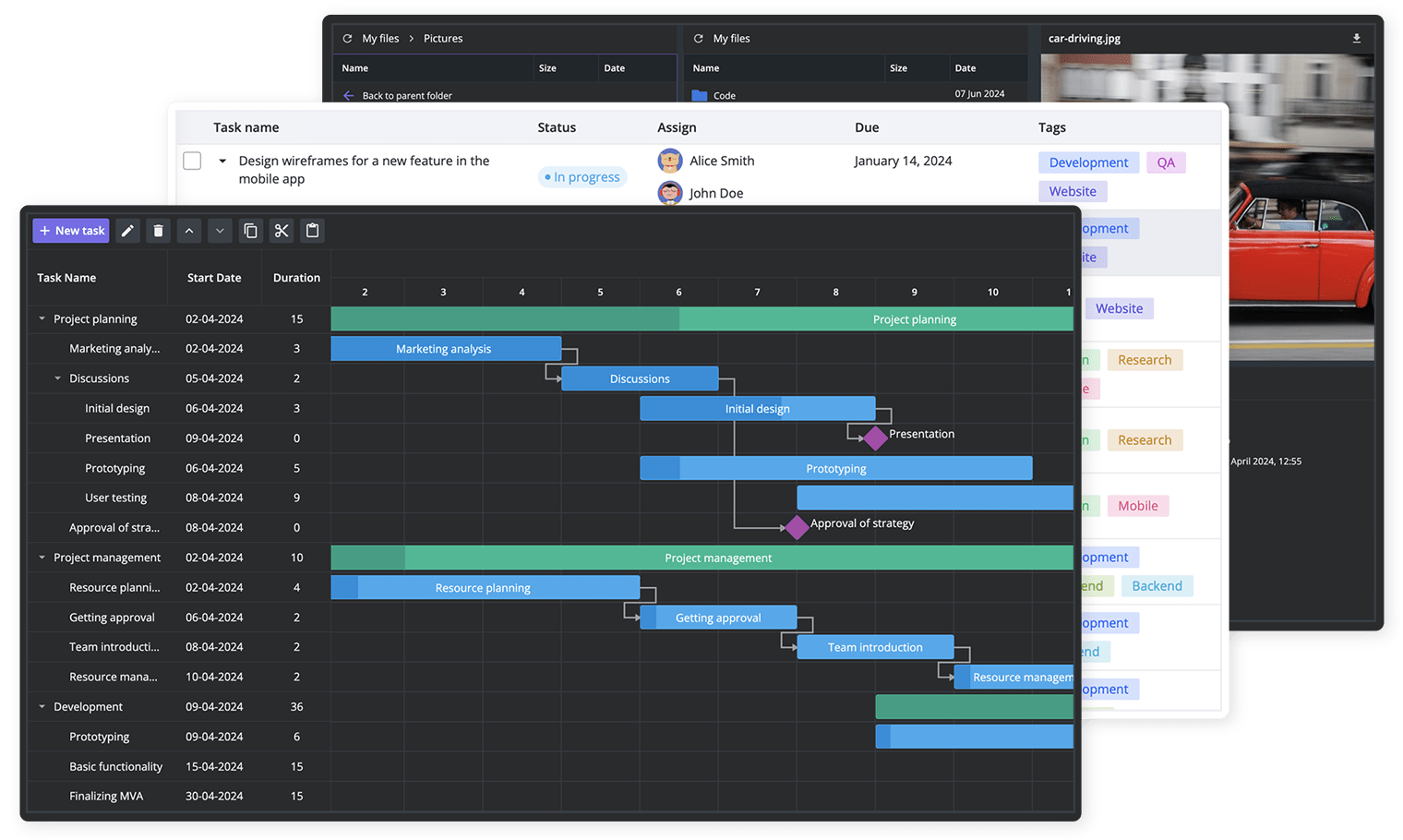
Beyond frameworks that help organize JavaScript logic and structure, there are also UI libraries for vanilla JS. They allow you to concentrate on developing complex features leaving all UI work to them. You don’t need to worry about cross platform and browser support, performance, extensibility, accessibility and compliance.
One of them is the Webix JS UI library for Vanilla JS. Unlike React or Vue, it doesn’t replace JavaScript’s core logic but provides a rich set of UI components that work with vanilla JS seamlessly. Look at the URL of this article. You’re on the Webix website (hello there!), and we know everything about our beloved library. Now, let us spill the details!
Best Vanilla JS UI Library for Those Who Like Clean Code and Clear Semantics
Webix is an extensive JavaScript library that offers over 100 ready-to-use UI components and 15 complex widgets such as Spreadsheet, Scheduler, File Manager, etc.
1. Enhanced UI Development
Using predefined components significantly reduces coding time and improves maintainability. In contrast to creating a table structure manually (remember the pasta analogy?), the library allows you to define your data table in just a few lines of code. Let’s take a look at how easy creating a data grid can be:
Example: Creating a JS Datagrid
columns:[
{ id:"title", header:"Film title", width:200},
{ id:"year", header:"Release year" , width:80},
{ id:"votes", header:"Votes", width:100}
],
data:[
{ id:1, title:"The Shawshank Redemption", year:1994, votes:678790},
{ id:2, title:"The Godfather", year:1972, votes:511495}
]
});
Check out the code snippet where you can make changes on the go: https://snippet.webix.com/8hq3amex
In contrast to creating a table structure manually, the library allows you to define your data grid in just a few lines of code. You can take advantage of the opportunities provided by JavaScript DataGrid – a standalone Vanilla JS component for working with large data sets that occupies the leading position on the market in terms of maybe highest data rendering speed.
2. Built-in State Management
Webix provides built-in data binding and state management features for layouts and data widgets (trees and tables). The majority of our complex widgets (Jet-based) support their own reactive states providing cross-view communication, i.e. interaction between different elements of the widget.
Our users can add reactive properties to configuration settings of the widget and get access to them through the getState() method. Reactive state enables the dynamic update of the UI in response to any changes resulting from user actions, data modification or any other events. With such an ace up your sleeve, you can focus on building your web application logic rather than worrying about managing the state effectively.

Check the code snippet to get the idea of how it works.
3. Modularity and Component Reusability
Webix JS UI Library is designed around the concept of components. You can create reusable components that inherit component logic and styles, making your application more modular. It suggests a wide range of complex widgets that supply users with advanced business solutions.
| Business Challenge | Webix Widgets that solve it |
| Time, task and project management | Scheduler, To Do List, Kanban, Gantt |
| File management | File Manager, Document Manager |
| Reports management, data management, filtering | Report Manager, Spreadsheet, Pivot Table/Chart, Query |
| Communication and exchanging messages | Chat |
| Administering users’ rights and permissions | User Manager |
| Building diagrams describing business processes | Diagram |
| Remote desktop opportunities | Desktop |
4. Support and Documentation
Webix comes with extensive documentation that is continuously being updated by technical writers. The User community on the forum and technical support helps developers to figure out how to deal with custom solutions. This can significantly reduce development time as you can rely on existing solutions for common problems rather than reinventing the wheel.
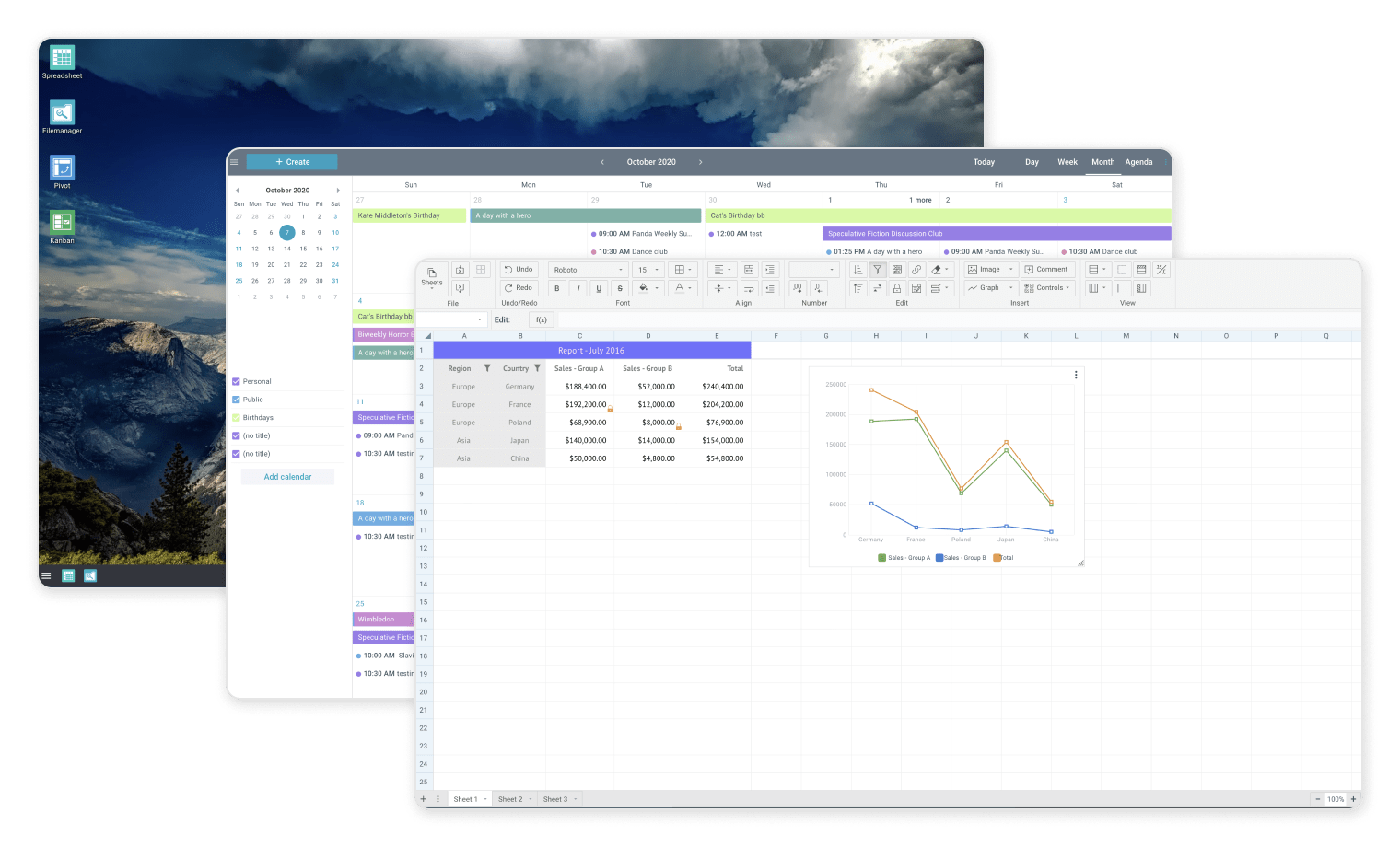
5. Easy integration
Webix offers a number of tools for integration, as well as provides an opportunity to design custom UI elements by wrapping JavaScript widgets into your framework components (AngularJS, React, Vue.js, Backbone.js, other).
You can find detailed information about integration here. Check this link to learn more about UI integration extensions.
Mission Accomplished: JS Knowledge Unlocked
Vanilla JavaScript is just pure JS — don’t fall for the tricks of joker developers! Sometimes, all you need is good old JavaScript and a bit of time to master its fundamental concepts.
But once you become a Vanilla JS ninja and start working on larger projects or in a team, frameworks become indispensable. They solve key challenges like maintaining a clear structure and providing reusable, modular components.
Beyond frameworks, there are also UI libraries that help streamline interface styling with minimal effort. Why choose between functionality and great design when you can have both?
Try Webix—with over 100 ready-to-use UI components, 15 complex widgets, clean and simple code, plus top-tier technical support and detailed documentation to get you started!
